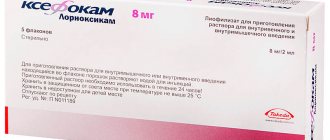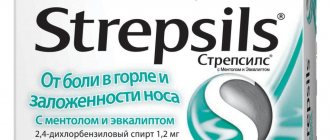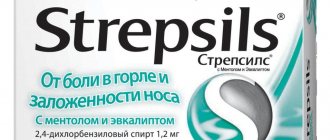Dosage forms and composition
Xefocam contains one active component - lornoxicam, which affects the production of prostaglandins. The drug is produced:
- In tablet form: with a dosage of 4–8 mg. Formative components: silicon dioxide, starch, lactose, magnesium stearate. White oblong pills are packaged in paper cellular blisters of 10 pieces. On the surface they have an engraving Lo and a dose designation - the number 4 or 8. The cardboard packaging of the medicine contains from 10 to 50 tablets.
- In the form of a lyophilisate for the preparation of solutions. Yellow dense mass placed in glass bottles - 5 pieces per package. One container contains a medicine in a dose of 8 mg, auxiliary compounds: mannitol, tromethanol.
Pharmacodynamics and pharmacokinetics
Pharmacodynamics
Anti-inflammatory non-steroidal drug. It has a pronounced analgesic and anti-inflammatory effect. Lornoxicam has a rather complex mechanism of action, which includes inhibition of prostaglandin synthesis caused by inhibition of cyclooxygenase activity. Blocking cyclooxygenase leads to suppression of peripheral pain receptors and relief of signs of inflammation.
Lornoxicam also reduces the production of oxygen radicals by leukocytes that have undergone activation. The analgesic effect of the drug is not associated with an opiate-like effect on the nervous system and is not accompanied by respiratory depression or drug dependence.
Does not affect important vital signs: respiratory rate, ECG readings, body temperature, heart rate, blood pressure, spirometry .
Pharmacokinetics of tablets
After oral administration, lornoxicam is quickly and completely absorbed from the intestine. In this case, the highest concentration in the blood occurs after an hour and a half. Eating reduces the maximum concentration by 30% and increases the half-life to 2.3 hours. The bioavailability of lornoxicam reaches 92-100%. Binding to blood proteins is 99% and does not depend on its content.
The active substance is completely transformed in the liver. The enzyme CYP2C9 is involved in the transformation . In plasma, the drug is present predominantly unchanged and, only to a small extent, in the form of a hydroxylated metabolite that does not have pharmacological activity.
The half-life is approximately 4 hours. About a third of the metabolites are excreted in the urine and the remainder in the bile.
In elderly people, as well as in patients with impaired liver and kidney function, no changes in the pharmacokinetics of the drug were detected.
Pharmacokinetics of solution for parenteral administration
When administered intramuscularly, the highest content of lornoxicam in the blood is achieved after 25 minutes. Bioavailability in this case reaches 97%, and the reaction with blood proteins is 99%.
Lornoxicam is found in plasma in unchanged form and also in the form of a hydroxylated metabolite that has no pharmacological activity.
The half-life is approximately 3.5 hours. Completely metabolized. About a third of the metabolites are excreted in the urine and the remainder in the bile.
In elderly people, as well as in patients with impaired liver and kidney function, no changes in the pharmacokinetics of the drug were detected.
Mechanism of action
Lornoxicam belongs to the category of non-opioid analgesics. In the body, it inhibits the activity of the enzyme cyclooxygenase, which is responsible for the synthesis of neurotransmitters of pain and inflammation. It also slows down oxidation reactions. The substance does not affect the thermoregulation center, breathing, the functioning of the cardiovascular system, and does not cause drug dependence.
Xefocam in tablets and solution is quickly absorbed into the blood, binding to its proteins. The analgesic effect is observed after 15–20 minutes, reaching its maximum after 1.5–2 hours. Within 3.5–4 hours, the substance is filtered by liver cells and gradually eliminated from the body through the kidneys and intestines. During its activity and elimination, the drug produces almost no metabolites.
If the instructions are followed, Xefocam does not have a pronounced toxic effect on internal organs. Its components do not accumulate in tissues. The product is approved for use by physical parameters in weakened people, with insufficient liver function and excretory system.
Xefocam®
The risk of ulcerogenic effects of the drug can be reduced by the simultaneous administration of proton pump inhibitors and synthetic prostaglandin analogues. If bleeding occurs in the gastrointestinal tract, the drug should be stopped immediately and appropriate emergency measures taken. It is especially necessary to carefully monitor the condition of those patients with gastrointestinal pathology who are receiving a course of treatment with XEFOCAM for the first time.
Like other oxicams, XEFOCAM inhibits platelet aggregation and may therefore increase bleeding time. When using this drug, patients who require completely normal coagulation function (for example, patients undergoing surgery), who have coagulation disorders, or who are receiving medications that inhibit coagulation (including low-dose heparin) should be closely monitored when using this drug. , in order to promptly detect signs of bleeding.
If signs of liver damage appear (itching, yellowing of the skin, nausea, vomiting, abdominal pain, dark urine, increased levels of liver transaminases), you should stop taking the drug and consult your doctor.
The drug should not be used simultaneously with other NSAIDs.
The drug can change the properties of platelets, but does not replace the preventive effect of acetylsalicylic acid in cardiovascular diseases.
In patients with impaired renal function caused by large blood loss or severe dehydration, XEFOCAM, as an inhibitor of prostaglandin synthesis, can be prescribed only after hypovolemia and the associated risk of decreased renal perfusion have been eliminated. Like other NSAIDs, XEFOCAM can cause an increase in the concentration of urea and creatinine in the blood, as well as water retention and
sodium, peripheral edema, arterial hypertension and other early signs of nephropathy. Long-term treatment of such patients with XEFOCAM can lead to the following consequences: glomerulonephritis, papillary necrosis and nephrotic syndrome with transition to acute renal failure. Patients with a pronounced decrease in renal function should not be prescribed XEFOCAM (see “Contraindications”). In elderly patients, as well as in patients suffering from arterial hypertension and/or obesity, it is necessary to control blood pressure levels.
It is especially important to monitor renal function in elderly patients, as well as in patients:
- simultaneously receiving diuretics;
- concurrently receiving medications that can cause kidney damage.
With long-term use of the drug XEFOCAM, it is necessary to periodically monitor hematological parameters, as well as renal and liver function.
When is Xefocam indicated: instructions
Among the indications for taking the medication: pain of various origins, subject to the action of non-steroidal analgesics. Including those caused by:
- rheumatoid arthritis;
- deforming arthrosis;
- gout;
- ankylosing spondylitis.
The medication effectively reduces pain to moderate and moderate-to-severe intensity. Xefocam does not affect the general course of diseases; it is used only for symptomatic therapy: in short courses.
The drug is used with caution for pathologies of the gastrointestinal tract, smoking, alcoholism, heart failure, and diabetes.
To whom is Xefocam contraindicated?
It is necessary to stop using an analgesic:
- with bronchial asthma complicated by polyposis;
- for erosive and ulcerative lesions of the mucous membranes of the stomach and intestines;
- internal bleeding, suspicion of its presence;
- decreased blood clotting, impaired hematopoietic functions;
- Crohn's disease;
- in the period after heart surgery;
- in case of severe liver dysfunction: cirrhosis, acute hepatosis, hepatitis;
- in case of individual intolerance or allergic reactions to the drug.
Contraindications also include: all stages of pregnancy, children under 18 years of age.
Side effects of the drug
Occasionally, while using Xefocam, nausea, dry mouth, decreased appetite, abdominal cramps, and swelling occur. In isolated cases, it is also possible:
- physical weakness, drowsiness;
- weight loss;
- increased irritability;
- the appearance of stomatitis;
- exacerbation of gastritis.
Overdose increases the risk of internal bleeding and perforation of a stomach ulcer.
Side effects
The most common adverse reactions to taking non-steroidal anti-inflammatory drugs are: the appearance of peptic ulcers , perforation of a hollow organ or bleeding of the gastrointestinal localization. Also noted are abdominal pain, vomiting, nausea, diarrhea, constipation, flatulence , dyspepsia , hematemesis , melena , exacerbation of colitis , ulcerative stomatitis , exacerbation of Crohn's disease , gastritis . Approximately 20% of patients taking this medication may develop adverse reactions.
- reactions from hematopoiesis: anemia , leukopenia , thrombocytopenia , increased duration of bleeding, ecchymosis ;
- reactions from the immune system: allergies;
- metabolic reactions: anorexia , weight gain or loss;
- mental reactions: depression , sleep disturbance, nervousness, confusion, anxious agitation;
- reactions from nervous activity: temporary mild headaches, dizziness, paresthesia , somnolence , tremor , taste disturbance, migraine ;
- reactions from vision: conjunctivitis , blurred vision;
- reactions from the vestibular apparatus: tinnitus, dizziness ;
- reactions from the circulation: tachycardia , palpitations, heart failure , edema, hot flashes , hemorrhages, arterial hypertension , hematoma ;
- reactions from the respiratory organs: rhinitis , dyspnea , pharyngitis , bronchospasm , cough;
- digestive reactions: abdominal pain, nausea, dyspepsia , vomiting , , flatulence , constipation, dry mouth, belching, peptic ulcer , gastritis , ulcerations in the oral mucosa, hematemesis, glossitis , melena , stomatitis , gastroesophageal reflux , esophagitis , aphthous stomatitis , dysphagia , perforated ulcer ;
- reactions from the hepatobiliary system: increased concentrations of glutamate-pyruvate transaminase and glutamate-oxaloacetate transaminase, damage to hepatocytes, impaired liver function;
- skin reactions: itching, rash, sweating, urticaria , dermatitis , alopecia , purpura , bullous reactions, edema, epidermal toxic necrolysis , Stevens-Johnson syndrome ;
- reactions from the musculoskeletal system: arthralgia , muscle spasms, bone pain, myalgia ;
- reactions from the urinary system: urinary disorders, nocturia , increased concentration of urea or creatinine in the blood;
- general reactions: facial swelling , malaise, asthenia .
How to use Xefocam
The medication in tablets is prescribed to adults at 4–8 mg per day. The maximum dose per day is 16 mg. The pills should be swallowed without chewing, with 50–100 ml of water. It is important to follow the regimen, taking the medicine orally before meals - 30–40 minutes. Food slows down absorption and reduces the activity of the analgesic in severe pain.
Xefocam injections are given intramuscularly or intravenously. A single dose of the drug is 8 mg. Before administration, the lyophilisate from the bottle is diluted with distilled water in a volume of 2 ml. If necessary, the injection of the drug is repeated after 4–6 hours.
Xefocam price, where to buy
The price of Xefocam in tablets of 8 mg No. 10 in Russia is about 250 rubles. For comparison, the price of 5 ampoules with lyophilisate is approximately 800 rubles.
Buying Xefocam 8 mg No. 10 in Ukraine will cost an average of 100 hryvnia, and the price of Xefocam No. 5 injections reaches 450 hryvnia.
- Online pharmacies in RussiaRussia
- Online pharmacies in UkraineUkraine
- Online pharmacies in KazakhstanKazakhstan
ZdravCity
- Xefocam tablets p.p.o.
8 mg 30 pcs. Takeda GmbH RUB 512 order - Xefocam liof. d/prig. solution for intravenous and intramuscular injection. 8mg vial. 5pcs Wasserburger Arzneumittelwerk GmbH
RUR 779 order
- Xefocam tablets p.p.o. 8 mg 10 pcs. Takeda GmbH
RUB 247 order
Pharmacy Dialogue
- Xefocam (vial 8 mg No. 5)Wasserburger
RUR 768 order
- Xefocam (tablet p/o 8 mg No. 10)Takeda
RUB 243 order
- Xefocam (tab.p.pl/vol.8mg No. 30)Takeda
516 RUR order
show more
Pharmacy24
- Xefocam 8 mg No. 10 tablets Nycomed Austria GmbH.Austria/Nycomed Austria GmbH.Austria,Nimechchina/Takeda GmbH, Nimechchina
94 UAH.order - Xefocam 4 mg N10 tablets Takeda GmbH, city of Vir-va Oranienburg, Germany
59 UAH order
- Xefocam 8 mg No. 5 lyophilisate Nycomed Austria GmbH.Austria/Takeda Austria GmbH,Austria
446 UAH. order
PaniPharmacy
- Xefocam tablets Xefokam tablets. p/o 8 mg No. 10 Germany, Takeda
110 UAH order
- Ksefokam bottle Ksefokam por. d/in. 8ml fl. No.5 Austria, Takeda Austria
481 UAH order
- Xefocam tablets Xefokam tablets. p/o 4 mg No. 10 Germany, Takeda
75 UAH order
show more
Compatibility of the drug with alcohol and other medications
During the period of use of the medication, alcohol should be avoided, since ethanol greatly enhances its toxic effect. Caution is necessary when using Xefocam simultaneously with Cimetidine, Heparin, Methotrexate, Corticotropin, diuretics, antihypertensive drugs from the group of beta blockers and ACE inhibitors. As a result of their combination, a mutual increase in toxicity is likely.
Xefocam is not recommended to be combined with other non-steroidal analgesics, since all of them are characterized by an anticoagulant effect - a decrease in blood clotting.
During the treatment period, you should also refrain from driving a car or operating complex equipment. Xefocam affects the speed of motor skills and mental reactions, which increases the risk of accidents.






